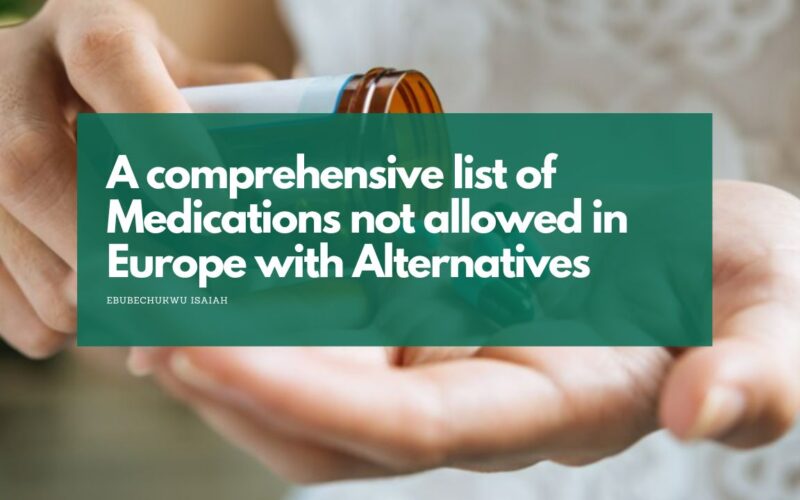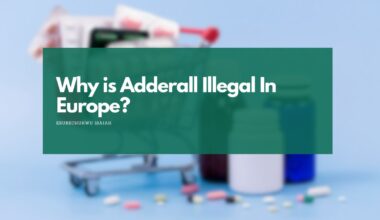As an Amazon Associate, I earn a small commission from qualifying purchases. Learn more about this.
Planning trips can be fun, they said. Everything will go smoothly, they said. Well, ‘they’ probably never found themselves at a foreign pharmacy being told, ‘Sorry, we don’t carry that medication.’
That’s what happened to me in Europe, and you wouldn’t believe what I’ve found out since then about the medicines that aren’t allowed there.
In this article, I’ll get into details of my take as well as a well-researched take on medicines that are not allowed in Europe, for my fellow travelers at Strangermiles.com.
Tap here to jump to the comprehensive list.
Why would Europe ban certain medications that are easily available elsewhere?
Finding out that Europe bans certain medications that I’ve known to be commonplace was like stumbling upon a hidden chapter in a familiar book. It begged the question: why would Europe, known for its advanced healthcare systems, say a firm ‘no’ to certain pills and potions easily available elsewhere?
The first thing to understand is that Europe takes an incredibly cautious approach to healthcare.
The European Medicines Agency (EMA), the body responsible for the scientific evaluation of medicines in the European Union, is stringent about what gets the green light.
Their decisions hinge on a complex balance of factors, primarily the medication’s effectiveness, risks, and impact on public health.
If a drug doesn’t measure up to their high standards, it’s a no-go. And trust me, these standards are nothing to scoff at; they’re in place to protect millions of people from potential health risks.
For instance, while researching, I discovered that certain painkillers available over-the-counter in other parts of the world are restricted in Europe. Why, you ask?
Well, it’s because of the potential for misuse, addiction, and serious side effects that these painkillers carry. Europe’s healthcare philosophy often leans more toward prevention and holistic well-being, rather than just treating a symptom. It’s not about denying relief but ensuring safety.
Another eye-opener was the environmental impact of medications.
Some substances are banned purely because they pose a risk to the environment.
Europe is stringent about its commitment to sustainability, and this extends to healthcare. Medications that could contaminate water supplies, harm wildlife, or disrupt ecosystems often face strict scrutiny or outright bans.
Moreover, there’s the fact that medicine is a constantly evolving field. New research can lead to old medications falling out of favor. The EMA continuously reviews the latest studies and can decide to withdraw a drug based on new evidence about its risks or ineffectiveness.
Top 5 Medications not allowed in Europe
Before we get into the comprehensive list (which will be covered in the next section) let’s take a look at the top 5 medication types restricted in Europe.
1. Sleeping Pills

Starting with a class of medications known as “sleeping pills” or sedatives – in Europe, certain brands are harder to come by than a good cup of coffee in a heatwave.
Medications containing specific active ingredients like melatonin, for instance, face tight restrictions.
While it’s a go-to sleep aid in many countries, in some European nations, it’s either a prescription-only drug or entirely off the market. The concern? Long-term health effects and potential misuse. European health authorities aren’t sleeping on the job; they’re quite awake to the risks these pills pose.
| Sleeping Pill Ingredient | Status (Fully Banned/Partially Restricted) |
|---|---|
| 1. Pentobarbital | Fully Banned |
| 2. Secobarbital | Fully Banned |
| 3. Amobarbital | Fully Banned |
| 4. Flunitrazepam | Partially Restricted |
| 5. Triazolam | Partially Restricted |
| 6. Methaqualone | Fully Banned |
| 7. Diphenhydramine | Partially Restricted (in high doses) |
| 8. Zopiclone | Partially Restricted |
| 9. Zolpidem | Partially Restricted |
| 10. Chloral hydrate | Partially Restricted |
| 11. Ethchlorvynol | Fully Banned |
| 12. Glutethimide | Fully Banned |
| 13. Meprobamate | Fully Banned |
| 14. Methyprylon | Fully Banned |
| 15. Clomethiazole | Partially Restricted |
| 16. Barbiturates (general) | Fully Banned (with rare exceptions) |
| 17. Benzodiazepines (certain types) | Partially Restricted |
| 18. Suvorexant | Partially Restricted |
| 19. Eszopiclone | Partially Restricted |
| 20. Ramelteon | Partially Restricted |
| 21. Doxylamine | Partially Restricted |
| 22. Phenibut | Fully Banned |
| 23. Propiomazine | Partially Restricted |
| 24. Flurazepam | Partially Restricted |
Keep in mind that restriction policies vary across different European countries.
2. Decongestants
Next up, we have decongestants, common soldiers in the fight against the pesky common cold. Medications containing pseudoephedrine or phenylephrine, popular in countries like the US, are looked at skeptically in Europe.
These substances can be used to manufacture illegal drugs, so they’re controlled more strictly than a top-secret recipe. You might find alternatives, but don’t expect your usual go-to’s to be on the shelves.
3. Pain Management drugs
Now, let’s talk pain management – a realm where Europe takes no prisoners.
You see, medications containing codeine or other opioids are under severe restriction. In some European countries, you need a prescription for even the lowest doses.
The reason is the high potential for addiction and abuse. Europe’s stern stance on opioids is a bold statement in the global conversation about the opioid crisis.
4. Antidepressants
Antidepressants also have a different story in Europe. Specific types, especially older ones like MAOIs (monoamine oxidase inhibitors), have more restrictions than a high-security vault.
Due to significant side effects and the availability of safer alternatives, these antidepressants are rarely used. It’s Europe’s way of saying, “We care about mental health, but safety comes first.”
5. ADHD Medications
Lastly, let’s touch on a sensitive topic: ADHD medications. Drugs like Adderall, widely prescribed in the US, are virtually non-existent in many European countries.
They’re amphetamines, substances Europe relates more to illegal narcotics than therapeutic goods. Alternatives exist, but they’re prescribed with an air of caution thick enough to slice.
The Comprehensive List of Medications Not Allowed In Europe
For a more detailed take and comprehensive look, here’s a table that goes into this…
| Medication Type | Common Active Ingredient | Reason for Restriction | Available Alternatives (if any) |
|---|---|---|---|
| Sleeping Pills | Melatonin | Concerns over long-term health effects and potential misuse | Prescription alternatives, sleep hygiene recommendations, herbal remedies like valerian root |
| Decongestants | Pseudoephedrine, Phenylephrine | Used in the manufacture of illegal drugs, potential for misuse | Other less potent decongestants, saline nasal sprays, steam inhalation |
| Pain Relievers | Codeine, Other opioids | High potential for addiction and abuse, public health concerns | NSAIDs (like ibuprofen), paracetamol, prescription-only higher potency painkillers |
| Antidepressants | MAOIs (Monoamine Oxidase Inhibitors) | Significant side effects, safer alternatives available | SSRIs (Selective Serotonin Reuptake Inhibitors), SNRIs (Serotonin-Norepinephrine Reuptake Inhibitors), counseling, lifestyle changes |
| ADHD Medications | Adderall (amphetamine salts) | High potential for abuse, classified similarly to illegal narcotics | Prescription alternatives (like methylphenidate), behavioral therapy, lifestyle adjustments |
| Sleeping Pills | Melatonin | Long-term health effects, potential misuse | Prescription alternatives, herbal remedies |
| Decongestants | Pseudoephedrine, Phenylephrine | Potential for misuse, used in illegal drug manufacturing | Saline nasal sprays, other decongestants |
| Pain Relievers | Codeine, Other opioids | Addiction potential, public health concerns | NSAIDs, paracetamol, other prescription options |
| Antidepressants | MAOIs | Serious side effects, interactions, safer alternatives available | SSRIs, SNRIs, therapy, lifestyle changes |
| ADHD Medications | Adderall (amphetamine salts) | Abuse potential, similar to illegal substances | Methylphenidate, therapy, lifestyle adjustments |
| Anti-Anxiety Pills | Benzodiazepines (e.g., Diazepam, Alprazolam) | Dependency, withdrawal, misuse | SSRIs, therapy, antihistamines for short-term use |
| Muscle Relaxants | Carisoprodol, Methocarbamol | Potential for abuse, safety concerns | Physical therapy, other prescription relaxants |
| Acne Medications | Isotretinoin | Severe side effects, especially during pregnancy | Topical retinoids, antibiotics, hormonal treatments |
| Antihistamines | Older sedating types (e.g., Diphenhydramine) | Side effects such as drowsiness, impaired driving | Newer, less-sedating antihistamines |
| Cough Suppressants | Dextromethorphan | Misuse, potential for high-dosage recreational use | Lozenges, honey, prescription options |
| Weight Loss Drugs | Sibutramine, Phentermine | Cardiovascular risks, potential for abuse | Diet, exercise, prescription alternatives |
| Migraine Medications | Ergotamines | Severe side effects, drug interactions | Triptans, NSAIDs, preventive medications |
| Diabetes Medications | Rosiglitazone | Cardiovascular risks, other safety concerns | Other antidiabetic medications (e.g., Metformin) |
| Osteoporosis Treatment | Strontium ranelate | Risk of heart attack, other severe side effects | Bisphosphonates, hormone replacement therapy |
| Smoking Cessation Aids | Varenicline | Psychiatric side effects, other safety concerns | Nicotine replacement therapy, Bupropion |
| Herbal Supplements | Ephedra (Ma Huang) | High blood pressure, heart problems, potential for misuse | Other herbal or non-herbal supplements |
| Antiarrhythmic Drugs | Dronedarone | Severe side effects including liver and lung injury | Other antiarrhythmic medications |
| Hormone Replacement Therapy | Conjugated equine estrogens | Risks of cancer, blood clots, heart disease | Other forms of hormone replacement therapy |
| Immunosuppressants | Ciclosporin (oral solution for treating dry eyes) | Risk of malignancies, infection, kidney issues | Other immunosuppressants, artificial tears |
| Anabolic Steroids | Various (e.g., Stanozolol, Nandrolone) | Abuse and misuse, severe physical and mental health risks | Permitted for limited medical uses with prescription |
| Thalidomide | Thalidomide | Severe birth defects, historical safety concerns | Other medications for leprosy, multiple myeloma; strict controls for use |
| Quinine (for leg cramps) | Quinine | Risk of serious side effects including cardiac arrhythmias, especially when used for unapproved indications like leg cramps | Other treatments for leg cramps, tonic water in small amounts |
| Certain Barbiturates | Various (e.g., Secobarbital, Amobarbital) | High potential for addiction, overdose risk, availability of safer alternatives | Other types of sedatives or anticonvulsants, prescription-required for some uses |
| Kava Kava Supplements | Kava (Piper methysticum) | Risk of liver damage | Other herbal supplements, with caution |
| Ephedrine and Pseudoephedrine (as diet aids or stimulants) | Ephedrine, Pseudoephedrine | Misuse as stimulants, high blood pressure, heart problems, potential for illegal drug manufacturing | Prescription decongestants, other weight loss aids |
| Sibutramine | Sibutramine | Increased cardiovascular events, stroke, uncontrolled hypertension | Diet, exercise, other prescription weight loss medications |
| Rimonabant | Rimonabant | Psychiatric side effects, including depression and suicidal thoughts | Other weight management strategies, under medical supervision |
| Synthetic Cannabinoids | Various (e.g., Spice, K2) | Severe physical and mental health risks, potential for abuse | Not applicable; illegal for recreational use |
| Certain Cold Medications | Dextromethorphan (in high doses) | Potential for abuse and high-dosage recreational use, health risks | Standard doses available OTC, prescription alternatives |
| Certain Nasal Decongestants | Ephedrine | Potential for misuse, high blood pressure, heart problems, use in illegal drug manufacturing | Other decongestants, prescription options |
| Some Herbal Remedies | Aristolochia (birthwort) | Carcinogenic properties, kidney toxicity | Other herbal or conventional treatments |
| Injectable Tanning Products | Melanotan | Lack of safety information, potential side effects | Sunscreen, natural sun exposure with caution |
| Performance-enhancing Drugs | Various | Unfair advantage in sports, health risks, potential for abuse | Not applicable; illegal for performance enhancement |
| Laetrile (B17) | Amygdalin | Ineffectiveness, potential toxicity, illegal for cancer treatment | Other cancer treatments, under medical supervision |
| Certain Dietary Supplements | DMAA (1,3-dimethylamylamine) | Health risks including cardiovascular problems | Other supplements, with caution |
| Certain Cosmetic Injectables | Silicone injections (for body enhancement) | Severe health risks, including toxicity and disfigurement | Regulated cosmetic procedures, medical-grade products |
| Certain Anti-Inflammatory Drugs | Rofecoxib, Valdecoxib | Cardiovascular risks, other severe side effects | Other NSAIDs, COX-2 inhibitors, analgesics |
| Certain Anti-Epileptics | Vigabatrin | Risk of permanent vision loss | Other anticonvulsants |
| Certain Cancer Medications | Tositumomab, Ibritumomab | Severe or life-threatening side effects, availability of safer or more effective alternatives | Other monoclonal antibodies or cancer therapies |
| Certain Diabetes Medications | Pioglitazone (in some countries) | Risk of bladder cancer | Other antidiabetic agents |
| Certain Anti-Arrhythmia Drugs | Amiodarone (for non-life-threatening arrhythmias) | Serious side effects including lung and liver damage | Other antiarrhythmic medications |
| Certain Vasodilators | Minoxidil (for oral use) | Severe side effects, potent blood pressure medication, misuse | Topical minoxidil for hair loss, other antihypertensives |
| Certain Herbal Extracts | Red yeast rice with high monacolin K levels | Potential for the same side effects as statin medications, lack of standardization | Statins under medical supervision, lifestyle changes |
| Synthetic Opioids | Fentanyl derivatives (for non-medical use), carfentanil | Extremely high potency and risk of fatal overdose, potential for abuse | Regulated medical use of fentanyl for severe pain, other pain management options |
| Certain Acne Medications | High-dose isotretinoin | Risk of severe birth defects, other serious side effects | Lower-dose isotretinoin, other acne treatments |
| Certain Anti-Anxiety Medications | Phenibut | Risk of dependence, withdrawal, and abuse | Other anti-anxiety medications, therapy |
Keep in mind that we’re still working to make this list as comprehensive as possible, which is not the case.
If you have any medication in mind that we’ve missed, contact us — we happily appreciate it!







